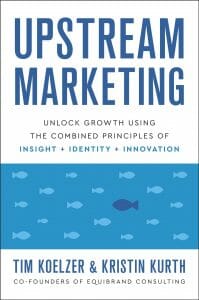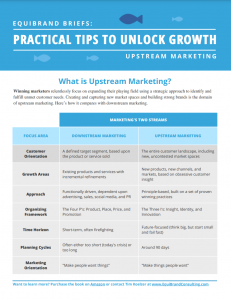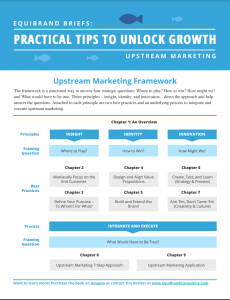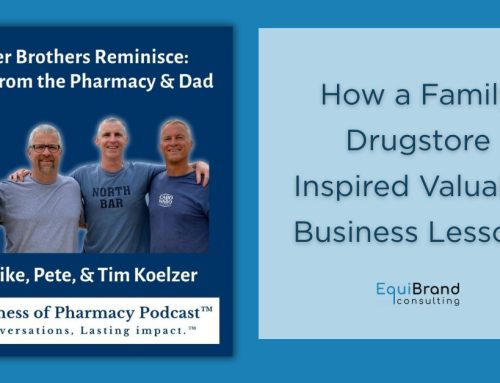What is Upstream Marketing?
Upstream marketing is a proactive, strategic approach that focuses on identifying and developing market opportunities long before products are designed or launched. It shifts the focus from selling existing products (downstream marketing) to understanding the market landscape, customer needs, and emerging trends to shape business strategy, product development, and brand positioning.
In contrast to downstream marketing, which involves promotion, sales, and distribution activities after a product is created, upstream marketing begins at the earliest stages of the product lifecycle. It is about making critical decisions such as what products or services to offer, who the target customers are, and how to differentiate these offerings in the marketplace. Tim Koelzer, in his book Upstream Marketing: Unlock Growth Using the Combined Principles of Insight, Identity, and Innovation, explains that upstream marketing is essential for sustainable growth and long-term success.
Upstream Marketing Vs Downstream Marketing: Key Differences
Understanding the differences between upstream marketing and downstream marketing is crucial for building a successful business strategy. Here’s a comparison:
- Focus and Timing:
- Upstream Marketing: Focuses on strategic decisions made during the early stages of product development. It emphasizes understanding market opportunities, customer needs, and competitive dynamics before creating products or services.
- Downstream Marketing: Occurs after the product is developed and ready to be sold. It involves activities such as advertising, sales promotion, and distribution to drive product awareness and generate sales.
- Objective:
- Upstream Marketing: Aims to shape the product or service offering to meet unmet customer needs and create a strong value proposition that differentiates the brand in the market.
- Downstream Marketing: Seeks to generate demand, increase product visibility, and persuade customers to purchase the existing product.
- Scope of Activities:
- Upstream Marketing: Includes market research, customer segmentation, value proposition development, brand positioning, and product concept development.
- Downstream Marketing: Encompasses advertising, public relations, sales promotions, distribution, and after-sales service.
- Impact on Business:
- Upstream Marketing: Sets the foundation for successful products and brand positioning. By aligning product offerings with market needs, it reduces the risk of product failure and enhances long-term profitability.
- Downstream Marketing: Directly influences short-term sales and revenue by increasing product awareness and persuading customers to buy.
- Customer Understanding:
- Upstream Marketing: Involves in-depth understanding of customer needs, pain points, and desires through comprehensive market research and customer insights.
- Downstream Marketing: Focuses on communicating product benefits and features to the customer, based on the existing understanding gained from upstream efforts.
Why is Upstream Marketing Important?
Investing in upstream marketing is crucial for businesses aiming to achieve sustainable growth and create lasting value. Here are some key reasons why upstream marketing is important:
- Strategic Differentiation: By understanding customer needs and market dynamics early on, businesses can create differentiated products and services that stand out in the market.
- Market Fit: Developing products that align with customer needs reduces the risk of product failure and enhances customer satisfaction.
- Growth Opportunities: Upstream marketing uncovers new opportunities for growth by identifying unmet customer needs and emerging market trends.
- Risk Mitigation: Early-stage decisions informed by customer insights and market analysis
Key Components of Upstream vs. Downstream Marketing
1. Insight
Insight is the foundation of upstream marketing. It involves a deep understanding of customer needs, desires, and behaviors, which enables businesses to develop products and services that resonate with their target audience. Here’s how to leverage insights effectively:
- Customer Segmentation: Identify distinct customer segments based on needs, behaviors, and preferences to create targeted marketing efforts.
- Market Research: Use qualitative and quantitative research to gather data on customer pain points, desires, and purchasing behaviors.
- Trend Analysis: Monitor industry trends and societal shifts to anticipate changes in customer needs and market conditions.
2. Identity
Identity in upstream marketing refers to a brand’s purpose, values, and positioning. A strong identity guides business decisions and helps build a cohesive brand strategy that aligns with customer expectations.
- Brand Purpose: Define the core purpose of the brand beyond making a profit. A strong purpose resonates with customers and drives loyalty.
- Value Proposition: Craft a compelling value proposition that clearly communicates the unique benefits of the product or service.
- Positioning: Establish a distinctive position in the market that sets the brand apart from competitors and appeals to the target audience.
3. Innovation
Innovation translates insights and identity into actionable strategies that drive product development and market success. It involves rethinking traditional business models and exploring new ways to meet customer needs.
- Product Innovation: Develop new products or enhance existing ones to better meet the evolving needs of customers.
- Business Model Innovation: Explore new business models that can deliver greater value to customers and create a competitive advantage.
- Customer Experience Innovation: Design superior customer experiences that delight customers and foster brand loyalty.
The Upstream Marketing Process
Step 1: Market Exploration
Market exploration involves identifying and evaluating potential opportunities in the market. This step includes:
- Market Sizing: Estimate the size of potential markets to assess the viability of new opportunities.
- Competitive Analysis: Analyze competitors to understand their strengths, weaknesses, and market positioning.
- Gap Analysis: Identify gaps in the market where customer needs are unmet or underserved.
Step 2: Opportunity Assessment
Once potential opportunities are identified, they need to be evaluated to determine which are worth pursuing. This step includes:
- Opportunity Prioritization: Rank opportunities based on factors like market size, growth potential, and alignment with the company’s capabilities.
- Business Case Development: Create a business case for each opportunity, outlining the potential return on investment, risks, and resource requirements.
- Strategic Fit: Assess the fit of each opportunity with the company’s strategic objectives and capabilities.
Step 3: Concept Development
Concept development involves creating product or service concepts that align with identified opportunities. This step includes:
- Idea Generation: Use creative brainstorming techniques to generate a wide range of ideas.
- Concept Testing: Validate ideas with target customers to refine and prioritize concepts.
- Prototype Development: Create prototypes or mock-ups to test the feasibility and appeal of concepts.
Step 4: Strategy Formulation
With validated concepts, the next step is to formulate a strategy for bringing them to market. This step includes:
- Product Strategy: Define the features, benefits, and unique selling points of the product or service.
- Go-to-Market Strategy: Develop a plan for launching the product, including marketing, sales, and distribution strategies.
- Resource Planning: Identify the resources required to bring the product to market, including budget, personnel, and technology.
Step 5: Implementation
The final step in the upstream marketing process is implementation. This step includes:
- Project Management: Manage the development and launch of the product, ensuring that timelines, budgets, and quality standards are met.
- Performance Monitoring: Track key performance indicators (KPIs) to measure the success of the product and identify areas for improvement.
- Iteration and Optimization: Use feedback from the market to refine and improve the product or service over time.
How Equibrand Can Help
At Equibrand Consulting, we specialize in helping companies unlock growth through effective upstream marketing strategies. Our team of experts works closely with clients to identify new opportunities, develop compelling value propositions, and create innovative strategies that drive business success.
Our Services
- Market Research and Customer Insights: We conduct in-depth research to uncover customer needs, behaviors, and preferences, providing the foundation for strategic decision-making.
- Brand Strategy and Positioning: We help companies define their brand purpose, craft compelling value propositions, and establish a distinctive market position.
- Innovation Strategy: We work with clients to develop innovative products, services, and business models that meet evolving customer needs and create competitive advantage.
- Go-to-Market Strategy: We assist clients in developing and executing effective go-to-market strategies that maximize the impact of new products and services.
Why Choose Equibrand?
- Proven Methodology: Our approach to upstream marketing is grounded in the principles outlined in Tim Koelzer’s Upstream Marketing. We apply a proven methodology that has helped companies across industries achieve sustainable growth.
- Expertise Across Industries: We have experience working with clients in various sectors, including healthcare, consumer goods, technology, and more.
- Collaborative Approach: We believe in working closely with our clients to understand their unique challenges and opportunities. Our collaborative approach ensures that we develop strategies that are tailored to their specific needs.
Conclusion
Upstream marketing is a powerful approach to driving business growth and achieving sustainable success. By focusing on market opportunities, customer needs, and strategic differentiation, companies can develop products and services that resonate with customers and stand out in the marketplace.
If you’re wondering “what is upstream marketing” and how it can transform your business, look no further than Equibrand Consulting. We are committed to helping companies unlock their full potential through effective upstream marketing strategies.
Contact Us Today
Ready to take your business to the next level? Reach out to Equibrand Consulting to discuss how we can help you leverage upstream marketing to unlock new growth opportunities and achieve sustainable success.


EquiBrand Briefs. Sign up to receive our latest insights and ideas to help you grow your business.
If you’re interested in learning more about the differences between upstream vs downstream marketing or speaking with someone at EquiBrand about our upstream consulting services, please use our contact form.





















Follow EquiBrand